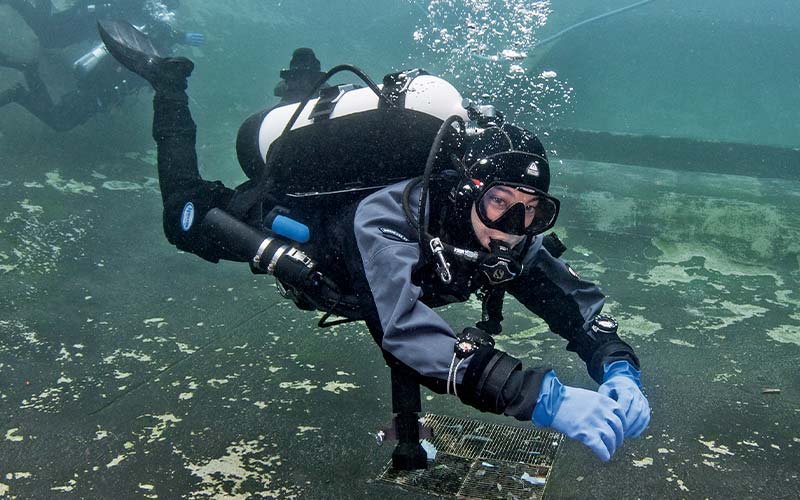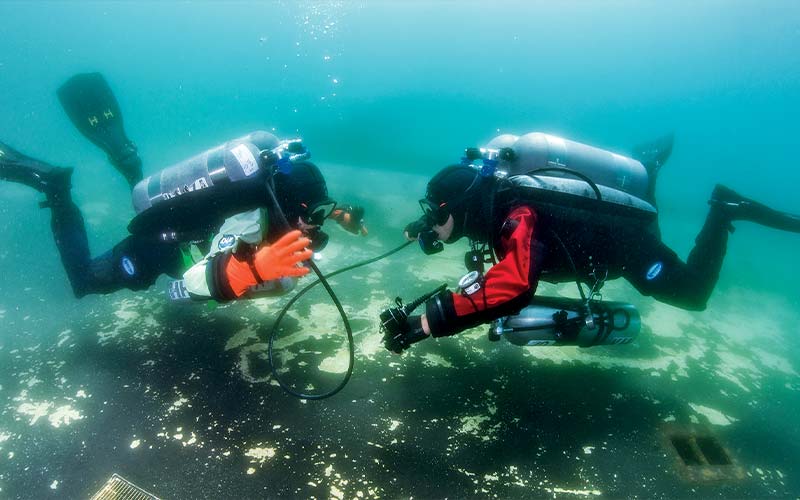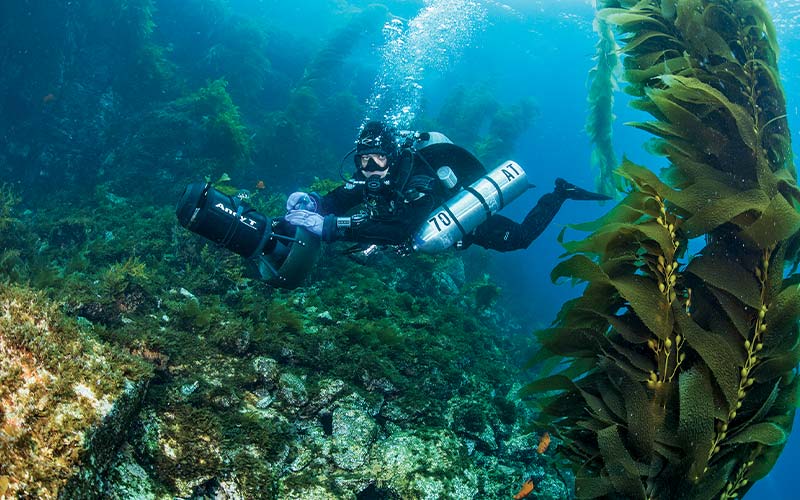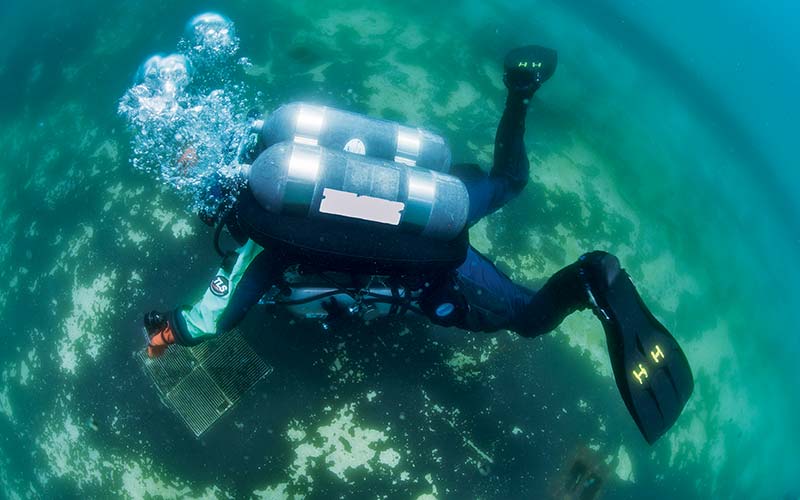These days there are a multitude of opportunities to expand your diving horizons. You can take a cavern- or ice-diving course, learn to dive sidemount, sign up for a nitrox or tech class or even get certified on a rebreather.
But whether you’re a beginning diver or an experienced one, perhaps the most important thing you can do to improve your diving is to master the ability to be neutrally buoyant and maintain a stable, horizontal position — also known as good trim — throughout the dive.
These skills are not learned overnight or through a training course alone. Without practice most divers find it difficult to maintain neutral buoyancy for more than a few moments while holding perfectly still, and many swim in a head-up, feet-down attitude (or position), which leads to excessive exertion as they move through the water.
But for those willing to do the work, the rewards are dramatic. Divers who perfect these techniques experience less fatigue, reduce their gas consumption, may learn new skills more easily, safeguard the environment and benefit from improved confidence and control underwater.

Underground Technique
Cave divers became strong proponents of good buoyancy and trim in the 1980s in response to the challenges of diving in an overhead environment. In caves, precise buoyancy control is critical; gas and energy are precious resources that must not be wasted through inefficient technique. Effective position control also prevents collisions with the cave, which can stir up silt and or knock debris from the ceiling, destroying visibility and jeopardizing the safety of the dive team.
Good trim is also essential in caves. By maintaining a streamlined horizontal orientation with the head forward, the legs bent at the knees and the feet elevated, divers minimize their surface area in their direction of travel and can therefore move through the water with less resistance. This reduces workload and gas consumption. Furthermore, movement up or down while horizontal is subject to greater resistance, which further enhances divers’ ability to control their position in the water column.
Defining Good Buoyancy and Trim
Explorer and educator Jarrod Jablonski, founder of Global Underwater Explorers (GUE), recognized the importance of these techniques outside of caves and created a program to promote and teach them in the late 1990s. His key insight was that some important skills in diving such as running a reel, shooting a surface marker buoy (SMB) or sharing gas with an out-of-air diver were easy once a diver had a stable platform to work from. Accordingly, Jablonski made buoyancy and trim the focus of GUE’s core curriculum in a course called GUE Fundamentals, which serves as the starting point for the organization’s recreational and technical training.

Most training agencies now offer a course or a module that addresses good buoyancy and trim (see sidebar). However, many divers have yet to get the message. Pick up a dive magazine or visit a popular dive site and you will see divers struggling through the water in “seahorse” position or a circle of divers kneeling on the seafloor to do drills. But the message is spreading. Recently the Professional Association of Diving Instructors (PADI), the world’s largest training agency, announced that it would begin emphasizing trim and buoyancy in its revised open-water training program beginning in 2014.
Good buoyancy and trim means being able to descend slowly in a horizontal position and then stopping at will without touching the seafloor or sculling with the hands. From there, the diver should be able to start swimming without breaking position or float motionless for several minutes in a horizontal position without rising or sinking. Divers should be able to clear their masks or share air with a dive buddy while maintaining good trim and without changing depth by more than a few feet. They should also be able to turn to the left or the right or even move backward using only their legs.
Putting It All Together
Taking a training course is probably the best way to begin to perfect your buoyancy and trim. Most of the available courses offer a mixture of lecture, pool practice and open-water dives.
One training method that can help you master these skills is the use of performance metrics. For example, specify a number of feet you may vary from your target depth during a training exercise or quantify in degrees how far you wish to permit yourself to deviate from horizontal (e.g., no more than 20° or 30°). Metrics offer a precise way to track and measure performance instead of relying on qualitative judgment alone.

A second method is using video to record your (or your students’) training exercises to get accurate feedback about progress. Video enables you to see what you’re doing right and what needs work. Underwater mirrors, which are sometimes used in pool practice, are also excellent feedback tools.
Typically the first step in training is making sure you have the right equipment and that it’s adjusted properly. Some divers find that traditional jacket-style BCDs tend to lift the upper part of the body, making it more difficult to maintain a horizontal position. For that reason, divers who desire a more horizontal attitude may prefer a back-mounted BCD or wings.
Maintaining proper trim is also more difficult if you rely solely on a conventional weight belt. The best approach is to distribute weight around your torso. This can be accomplished by using a stainless-steel back plate, a steel tank and/or keel or tail weights.
Finally, it’s important not to be overweighted, which necessitates putting more gas into the BCD, which increases drag and, thus, the energy required for swimming. Weight yourself so you are able to hold your position in 10 feet of water when your tank is nearly empty.
Basic Propulsion Techniques
The following propulsion techniques can improve your trim, stability and buoyancy control.

Frog Kick: The frog kick is the kick used when swimming the breaststroke. The legs mirror each other. This kick is powerful enough to be used in strong currents, and it’s relatively easy on the leg muscles, so it can be maintained for extended periods.
Flutter Kick: In contrast to the open-water flutter kick, the bent-leg flutter uses only the lower half of the legs for propulsion. Keeping the knees bent, the diver kicks and recovers one leg and then the other in rapid succession, initiating movement from the knee joint. The movement is completed by the ankles, which whip the water back and up with each cycle. The hips and thighs stay motionless throughout and should not dip below the horizontal plane of the body.
Back Kick: The back kick is extremely useful for adjusting and maintaining your position relative to your dive buddy, the reef, a wall or a shipwreck. It’s an essential kick for instructors, cave divers and underwater photographers. The kick applies the same concept as the frog kick but in reverse. It’s a challenging but worthwhile kick to learn.
Helicopter Turn: The helicopter turn enables divers to turn completely around without breaking horizontal trim or flapping their arms. As a result, the turn minimizes the movement of gas in your BCD or drysuit and therefore helps maintain stability. The movement is essentially a combination of the back kick and the frog kick. One foot completes one of the movements before the other foot starts the other one, and the diver pivots around a vertical axis without dropping the lower back or the knees.
Practice is Key
Once you’ve completed your course, you’ll need to practice your new buoyancy and trim skills until muscle memory is established. This may take dozens of hours. Consider practicing in a pool as well as during your dives. Progressive practice is an effective approach. Start by floating motionless at your target depth and then add skills such as mask clearing, valve shut-off drills or gas sharing while remaining neutrally buoyant and holding a trim position. Practice making three-minute stops at 10-foot intervals while descending and ascending. And practice your kicks. By building your skill level progressively, you’ll have a solid diving platform and, with it, greater confidence and control — and more fun.
© Alert Diver — Q4 Fall 2013